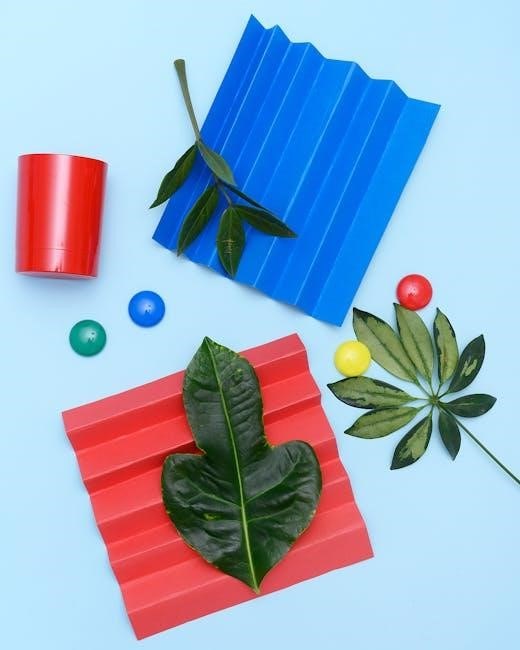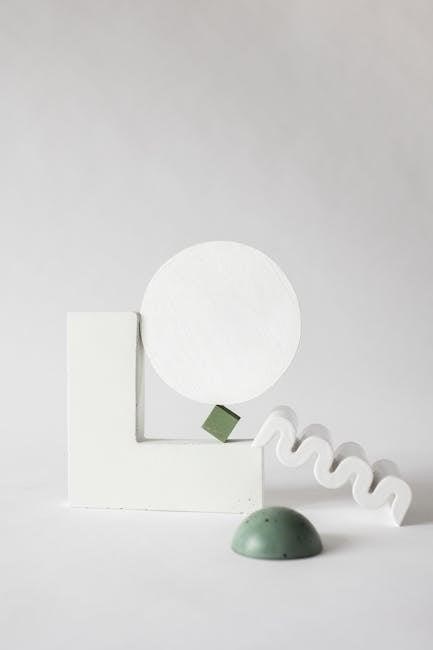The elements of art are fundamental components used to create and analyze visual works. Worksheets simplify learning these concepts, making art education accessible and engaging for students of all levels.
What Are the Elements of Art?
The elements of art are the fundamental components used to create and analyze visual works. They include color, line, shape, space, texture, form, and value/tone. These elements serve as the building blocks for artistic expression, allowing artists to communicate ideas and emotions effectively. Each element plays a unique role: color explores light and hue, line involves movement and direction, shape defines geometric or organic forms, space creates depth and perspective, texture adds tactile qualities, form represents three-dimensional objects, and value/tone manipulates light and dark. Understanding these elements is essential for both creating and appreciating art, making them a cornerstone of art education.

Importance of Worksheets in Art Education
Worksheets play a vital role in art education by providing structured learning opportunities. They help students understand and apply the elements of art through hands-on activities. Worksheets ensure that learners can grasp complex concepts, such as color theory or perspective, in a simplified manner. They also serve as tools for assessing comprehension and skill development. By incorporating exercises and creative tasks, worksheets make learning engaging and accessible. For instance, a worksheet on color might include mixing exercises, while one on shape could involve identifying and drawing forms. Such resources are invaluable for both teachers and students, fostering a deeper appreciation and mastery of artistic principles. Worksheets like the Twinkl Elements of Art Worksheet are particularly effective for this purpose.

Key Elements of Art
The key elements of art include line, shape, form, value, color, texture, and space. These foundational components guide artistic expression and creativity, essential for understanding visual composition.
Line and Shape

Line is a continuous mark made on a surface by a moving point, expressing direction, rhythm, and movement. It can vary in width, length, and curvature, adding energy to compositions. Shape refers to a self-contained area with height, width, and depth, often created by lines or other elements. Shapes can be geometric, like squares or circles, or organic, like free-form designs. Together, line and shape are essential for creating balance and structure in art. Worksheets on these elements help students explore their uses, practice techniques, and develop foundational skills. By experimenting with line and shape, artists can convey emotions and ideas, making these elements indispensable in visual expression and education.
Value and Color

Value refers to the lightness or darkness of a color or object, creating depth and mood in art. It ranges from pure black to pure white, with shades of gray in between. Color, derived from light, is a powerful tool for communicating emotions and ideas. Colors can be primary, secondary, warm, or cool, each evoking different responses. Worksheets focusing on value and color help students explore techniques like shading, color mixing, and contrast. By mastering these elements, artists can create dynamic, expressive compositions. Understanding value and color is crucial for developing visual harmony and emotional impact in artwork, making them essential skills for art education and practice.

Advanced Elements of Art
Advanced elements of art, such as texture and form, enhance creative expression and depth. Worksheets provide structured exploration, helping students master these complex visual components effectively.

Texture and Space
Texture refers to the surface quality of an object, either real or implied, while space defines the sense of depth and distance in a composition. Worksheets on texture often include exercises where students create tactile experiences using various materials or simulate textures through drawing techniques. For space, activities might involve layering, perspective, and overlapping shapes to convey three-dimensional environments. These exercises help students understand how texture adds realism and how space can create illusions of distance, enhancing their ability to communicate visually. By practicing these elements, learners develop a stronger foundation in creating dynamic and engaging artworks. These concepts are vital for building sophisticated compositions.
Form and Its Role
Form is a three-dimensional element of art, created by combining lines, shapes, and textures. It gives objects a sense of volume and mass, making them appear solid and tangible. Worksheets on form often include exercises where students sketch or construct shapes to understand how light and shadow define dimensions. Activities may involve creating still-life compositions or experimenting with geometric and organic forms. By exploring form, students learn to convey depth and structure in their art, adding complexity to their work. This understanding is crucial for creating realistic and visually compelling pieces, as form bridges the gap between two-dimensional representations and three-dimensional reality.
Benefits of Using Worksheets
Worksheets provide a structured way to engage with the elements of art, making complex concepts accessible through hands-on activities that enhance learning and creativity.
Educational Value

Worksheets on the elements of art provide structured learning, helping students grasp fundamental concepts like color, line, and shape. By breaking down complex ideas into visual examples and practical exercises, worksheets make art education accessible. They enable students to explore and understand how these elements interact in creating visual harmony. This structured approach fosters critical thinking and creativity, allowing learners to apply their knowledge in practical art-making activities. Worksheets also serve as valuable resources for reinforcing classroom lessons, ensuring that students retain key information and develop a strong foundation in art principles. Regular use of such materials encourages a deeper appreciation for art and its various forms, preparing students for more advanced creative challenges.
Skill Development
Engaging with elements of art worksheets fosters a range of essential skills in students. These resources provide hands-on opportunities to practice techniques, enhancing understanding of fundamental art principles. By completing exercises, students develop their ability to observe, analyze, and apply elements like line, shape, and color. Worksheets encourage creativity, as learners experiment with different visual effects. They also improve fine motor skills through drawing and drafting activities; Critical thinking is sharpened as students solve problems related to composition and balance. Over time, these exercises build confidence and proficiency, enabling students to create more complex and meaningful artworks. The structured format of worksheets ensures steady progress, making them an invaluable tool for skill development in art education.

Using the Worksheet Effectively
Worksheets are designed to maximize learning potential, offering a structured format for exploring and reinforcing the elements of art. They provide clear guidance for both students and educators.
Step-by-Step Guide
To effectively use an elements of art worksheet, begin by reviewing each element (line, shape, value, color, texture, space, and form) with clear definitions and examples. Next, complete exercises that identify and apply these elements in various artworks. Use the worksheet to sketch or describe how each element contributes to the overall composition. Finally, reflect on your understanding by answering review questions or creating an original piece incorporating all elements. This structured approach ensures a comprehensive grasp of artistic principles while fostering creativity and critical thinking skills.
Tips for Effective Learning
Start by setting clear goals for understanding each element of art. Use visual examples to aid comprehension, and sketch elements in artworks to identify their application. Practice regularly, even for short periods, to reinforce learning. Reflect on mistakes to improve understanding. Seek feedback from teachers or peers to gain new insights. Apply learned concepts by creating original artworks. Use online resources, like PDF worksheets, to supplement your studies. Stay curious and explore how elements of art interact in different styles and cultures. Consistent practice and creative application will enhance your mastery of artistic principles.

Mastering the elements of art through worksheets enhances creativity and understanding. Regular practice and exploration of artistic principles foster skill development and appreciation for visual expression.
The elements of art, including line, shape, color, value, texture, space, and form, are the foundation of visual expression. Worksheets play a crucial role in art education by providing structured activities that help students understand and apply these principles. They offer a hands-on approach to learning, making complex concepts accessible and engaging. By completing worksheets, learners can explore artistic techniques, develop creativity, and refine their skills. These resources are particularly beneficial for beginners, as they provide clear guidance and opportunities for practice. Ultimately, worksheets serve as invaluable tools for fostering a deeper appreciation and mastery of the elements of art, preparing students for more advanced creative projects.
Encouragement for Further Study
Exploring the elements of art through worksheets is just the beginning of a rewarding journey in creative expression. To deepen your understanding, consider experimenting with various artistic techniques and mediums, such as painting, drawing, or digital art. Practicing regularly will help refine your skills and foster creativity. Additionally, studying the works of renowned artists can provide inspiration and insights into how the elements of art are applied in different styles. Engaging with art communities, attending workshops, or enrolling in art courses can further enhance your learning experience. Remember, art is a lifelong journey, and continuous exploration will unlock new possibilities for self-expression and growth.